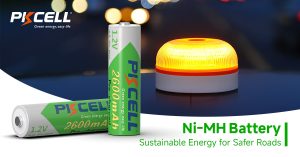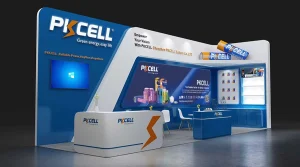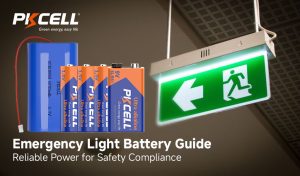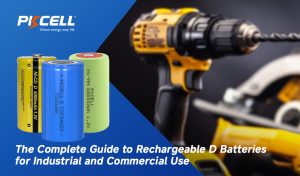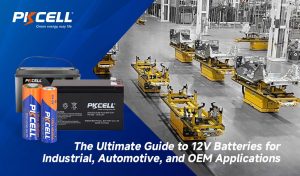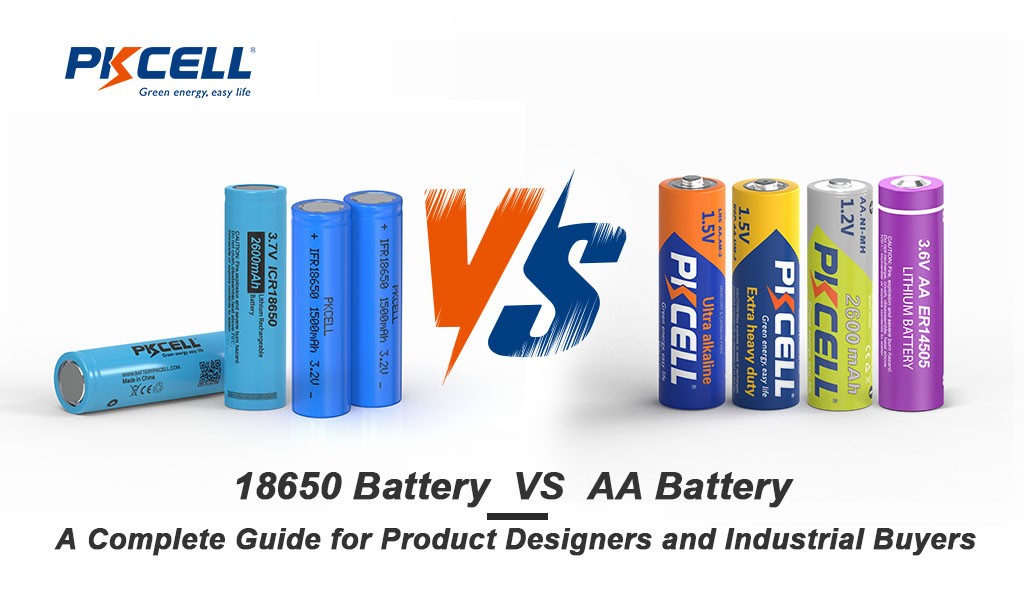
Principais destaques
- 18650 batteries are rechargeable lithium-ion cells widely used in high-power electronic devices, whereas AA batteries offer both alkaline and rechargeable options, suited for household gadgets.
- The nominal voltage of 18650 batteries ranges between 3.6V to 3.7V, compared to AA batteries, which typically operate at 1.2V to 1.5V.
- 18650 batteries have larger dimensions, higher energy density, and longer cycle life, making them optimal for demanding applications.
- AA batteries are compact and cost-effective, ideal for low to medium-power devices like remote controls or toys.
- Industrial buyers must consider factors like power output, rechargeability, and safety management when selecting between the two.
Why This Comparison Matters?
Picking the right battery is key if you want your design to work well. When you look at 18650 lithium-ion batteries and AA alkaline or NiMH batteries, you can see big differences. This matters a lot for those who buy for industry or design new products and want to get the best power for their needs.
These batteries do not have the same energy density, nominal voltage, or size. Because of this, each one fits different kinds of electronic devices. By knowing these things, you can choose the best battery for what you need, like for powerful tools or basic home gadgets.
Fundamental Differences: 18650 Batteries vs. AA Alkaline/NiMH Batteries
Core Chemistry
The chemistry inside a battery is what makes it different. 18650 batteries use lithium-ion, which gives them higher energy density than AA batteries. Because of this lithium-based makeup, they can store more power. This makes them good for things that need steady and long-lasting energy.
On the other hand, AA batteries are usually made with alkaline or nickel-metal hydride chemicals. Alkaline batteries are for single use. They work well if you have things that do not use much energy. Rechargeable AA batteries use NiMH chemistry and can be recharged many times. Still, they do not store as much energy as lithium-ion cells.
Voltage, Capacity, and Energy Output Comparison
18650 batteries have a higher nominal voltage than AA batteries. The regular voltage for an 18650 battery is about 3.6V to 3.7V, while an aa battery is between 1.2V and 1.5V. This means 18650 batteries often be better for things that use a lot of power.
They also hold more charge. The 18650 batteries usually have a capacity from 2200mAh up to 3600mAh. AA batteries can be anywhere from 700mAh to 2800mAh. Because of their high energy density, 18650 cells work 1.5 to 2 times better than AA batteries for things that need a lot of power.
|
Parameter |
Bateria 18650 |
Pilha AA |
|---|---|---|
|
Tensão nominal |
3,6V - 3,7V |
1.2V – 1.5V |
|
Gama de capacidades |
2200mAh – 3600mAh |
700mAh – 2800mAh |
|
Densidade energética |
150-220Wh |
/ |
Physical Dimensions
18650 batteries have a cylindrical shape and are about 18mm wide and 65mm long. These are bigger than AA batteries, which are often 14.5mm wide and 50.5mm long. Size is something you need to think about in design. Laptops and power tools often utilize spaces designed specifically for 18650 batteries due to their cylindrical shape. AA batteries, on the other hand, are commonly used in small household devices, such as remote controls.
Performance Metrics
Caraterísticas de descarga
Discharge rate shows how fast energy leaves a battery. 18650 batteries have a steady power output. They keep working the same way through their use because of their high energy density.
When you look at AA batteries, which are mostly alkaline or NiMH, they lose energy faster. They give enough power for things you only use sometimes, like a flashlight or a toy. Rechargeable AA batteries can last a bit longer, but they still do not match what lithium-ion types like the 18650 can do.
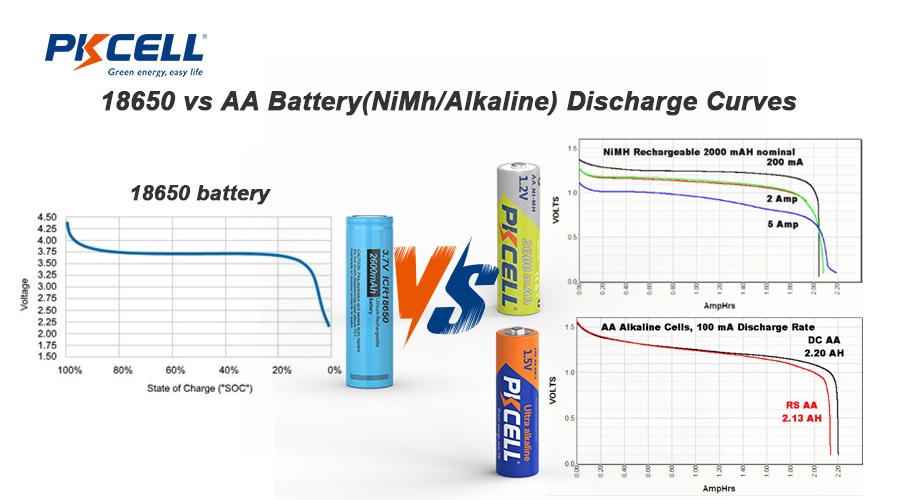
Cycle Life and Longevity
18650 lithium-ion batteries offer a cycle life of more than 500 to 4000 charge and discharge cycles. This long life is important for things that use a lot of power, like power tools or electric cars.
Rechargeable AA batteries, such as NiCd and NiMH types, give about 500 to 1500 cycles. They are helpful, but they do not last as long. In the case of single-use alkaline AA batteries, you need to throw them away often. This can create problems for the environment.
Self-Discharge Rates and Shelf Life
18650 batteries have a low self-discharge rate. This means the battery can keep its charge for a long time. They are great for things you use only sometimes. Many people use them in laptops or cameras.
On the other hand, AA batteries tend to lose their charge faster. Rechargeable aa NiMH batteries, for example, do not hold power as well if you leave them unused for some time. The normal alkaline AA batteries may last a bit longer on the shelf, but over time, they do not stay good for as long as others.
If you need to store batteries for a long time before using them, pick ones with better shelf life. This helps your devices work well when you need them.
Safety, Management, and Environmental Considerations
Safety is important when you pick a battery for a sensitive job. The 18650 lithium-ion batteries need a strong battery management system. This is to stop them from getting too full, too hot, or empty in the wrong way. In the factory and during use, their mix of chemicals means you have to be careful.
On the other hand, AA batteries—whether they are single-use alkaline or rechargeable NiMH—are not as risky, but they do have some problems for the environment. If you throw out old AA batteries in the wrong way, it can get into the ground and water and make it bad.
Cost Analysis
When you want to compare the cost of 18650 batteries with AA batteries, you have to look at both the starting cost and how much you will spend over time. The price of 18650 lithium-ion batteries can be higher at first. But these batteries have a high energy density, and you can recharge them many times. Using 18650 batteries for things like power tools or remote controls often helps you save money in the long run.
On the other hand, regular AA batteries have a lower capacity and do not last as long. You will have to replace them more often with your remote controls and other stuff. This leads to higher costs over time. By looking at these points, you will be better able to choose the right battery for your needs.
Escolher a bateria certa para as suas necessidades
The needs of your device decide which battery works best. 18650 batteries have a high energy density. These are ideal for items such as power tools, laptops, and electric vehicles. They work well in places where you need something that lasts long and holds a lot of power.
Click Here to quote for 18650 batteries
AA batteries, including those that can be recharged, are used for smaller devices. They are perfect for home electronic devices like remote controls, alarm clocks, and camera flashes. AA batteries are ideal for applications where less power is required.
Click Here to quote for AA Alkaline batteries
Click Here to quote for AA Ni-MH batteries
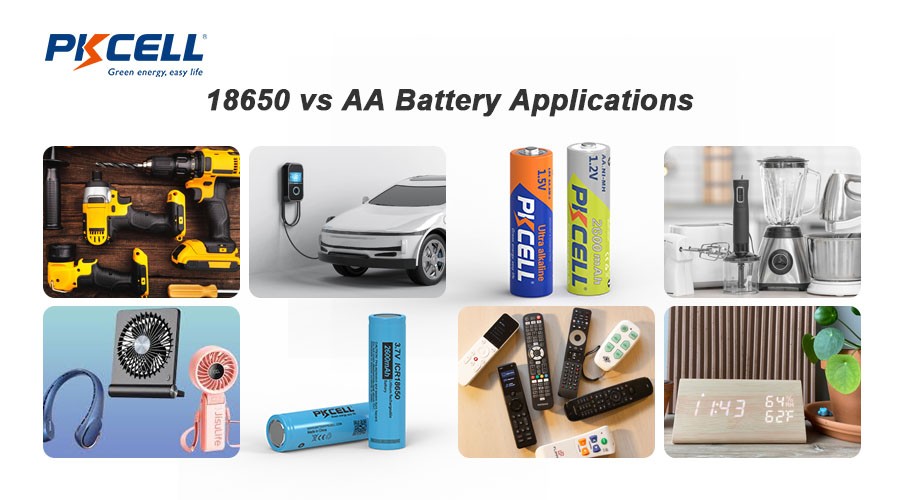
Why Choose Pkcell as Your 18650 and AA Batteries Supplier?
PKCELL is a leading B2B battery supplier with over 20 years of experience, offering high-quality 18650 lithium-ion and AA batteries for a wide range of industrial and commercial applications. Our 18650 batteries provide high energy density and long cycle life, ideal for energy storage systems and power tools. Our AA batteries, available in both alkaline and rechargeable NiMH versions, deliver reliable, long-lasting performance for everyday and professional devices. With advanced manufacturing, strict quality control, and certifications like ISO9001, CE, and RoHS, PKCELL ensures consistent product quality and dependable supply.
Reach out to us today for custom solutions and bulk pricing.
Conclusão
To sum up, it is important for product designers and industrial buyers to know the differences between 18650 and AA batteries. You need to consider factors such as how the battery stores energy, its efficiency, safety, and cost. This will help you pick what is best for your project. Both 18650 and AA batteries have their advantages and disadvantages, so you should consider what you really need before selecting a supplier. Pkcell has high-quality 18650 and AA batteries for many uses. If you want to proceed with the right batteries or need more information or assistance, please don’t hesitate to contact us.
Perguntas mais frequentes
What devices are best suited for 18650 vs AA batteries?
18650 batteries have high energy density. The high energy density makes them good for things that need more power, like laptops and power tools. AA batteries fit better for small things like remote controls, toys, or cameras. Think about what your device needs, then pick the one that fits best.
Can you charge an 18650 battery with an AA charger?
No, 18650 lithium-ion batteries and AA batteries are not the same, as they have different nominal voltage ratings. They also need different ways to charge them. Trying to charge an 18650 battery with a charger made for AA batteries can be unsafe. It might hurt the charger or the battery.
What safety factors should designers consider when choosing between 18650 and AA batteries?
Designers have to think about the safety of lithium-ion 18650 batteries. It is important to use a good Battery Management System (BMS) to keep the batteries from getting too hot. For AA batteries, you should follow the rules for how to throw them away in the right way. This helps with environmental considerations, especially for one-time use alkaline batteries.

 Bateria de lítio recarregável por USB
Bateria de lítio recarregável por USB
